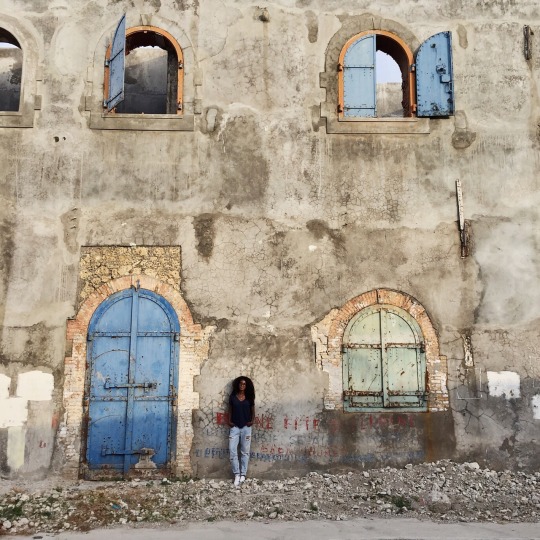Photo

On the Edge: Writing the Border between Haiti and the Dominican Republic (American Tropics: Towards a Literary Geography) by Maria Cristina Fumagalli
On the Edge: Writing the Border between Haiti and the Dominican Republic is a literary and cultural history which brings to the fore a compelling but, so far, largely neglected body of work which has the politics of borderline-crossing as well as the poetics of borderland-dwelling on Hispaniola at its core. Over thirty fictional and non-fictional literary texts (novels, biographical narratives, memoirs, plays, poems, and travel writing), are given detailed attention alongside journalism, geo-political-historical accounts of the status quo on the island, and striking visual interventions (films, sculptures, paintings, photographs, videos and artistic performances), many of which are sustained and complemented by different forms of writing (newspaper cuttings, graffiti, captions, song lyrics, screenplay, tattoos).
Dominican, Dominican-American, Haitian and Haitian-American writers and artists are put in dialogue with authors who were born in Europe, the rest of the Americas, Algeria, New Zealand, and Japan in order to illuminate some of the processes and histories that have woven and continue to weave the texture of the borderland and the complex web of border relations on the island. Particular attention is paid to the causes, unfolding, and immediate aftermath of the 1791 slave revolt, the 1937 massacre of Haitians and Haitian-Dominicans in the Dominican Northern borderland as well as to recent events and topical issues such as the 2010 earthquake, migration, and environmental degradation.
On the Edge is an invaluable multicultural archive for those who want to engage fully with the past and present of Hispaniola and refuse to comply with the idea that an acceptable future is unattainable.
36 notes
·
View notes
Photo
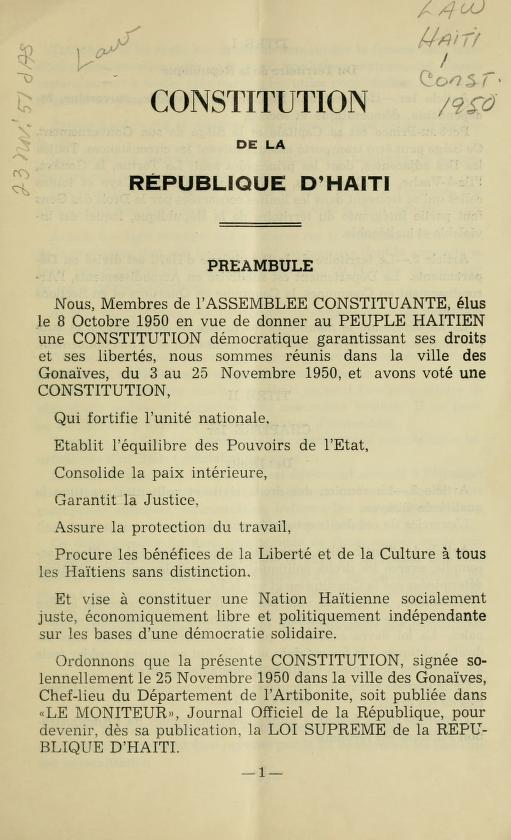

Today in Haitian History - November 25, 1950 – Enactment of the 1950 Constitution
Considered progressive in its time, this new Constitution captured the spirit of social change in Haiti started by the end of the U.S. occupation of Haiti in 1934 and accelerated in the post-Élie Lescot period (after January 1946). Among other important innovations, this Constitution promised universal suffrage, granting Haitian women the right to vote in presidential elections.
The 1950 Constitution also stipulated that Haitian heads of state could no longer serve for more than 6 years (a term) and could not hope for immediate re-election. The consequence of this decision became apparent in 1956 when Paul Eugène Magloire (right) tried to expand his time and power and created a constitutional crisis finally “resolved” with the election of François Duvalier in 1957.
Images Courtesy of: Archieve.Org and Encyclopædia Britannica.
50 notes
·
View notes
Photo

Haitian storytelling and Rara music in Crown Heights, Brooklyn - Nov 1st
"The sights, sounds and stories of Haiti are coming to a street near you.
Next weekend, a group of musicians and artists from the Caribbean nation will perform in a one-time “storytelling procession” in Crown Heights, sharing a longtime Haitian tradition with the surrounding neighborhood, organizers said.
The public parade, set for Nov. 1, will emulate the traditional “rara” musical performances that take place on many Sundays in Haiti, said Regine Roumain, co-founder of the Crown Heights-basedHaiti Cultural Exchange. During Lent or carnival days, especially, it’s typical to see groups of people playing metal horns, bamboo trumpets and drums in the street while storytellers perform songs and folktales, she said."
21 notes
·
View notes
Text
Top 10 U.S. States with Haitian Immigrants
Can you guess which U.S. states are home to the most Haitians?
We’ve gathered the top ten list of U.S. states that have attracted Haitian immigrants over the past decade. If you’d like to have some fun, take a moment to pull out a piece of paper and a pen (yes, we’re going old school), and make your top ten guesses! (While creating your list, keep in mind these numbers include only those born in Haiti – not their kids or grandkids…)
Ready? Let’s see how many you got right!
1. Florida
Was this an easy one? Florida is by far home to the most Haitian immigrants, with 280,000 of its residents being born in Haiti. Miami, Ft. Lauderdale, and West Palm Beach’s counties alone account for over 200,000 of this population – a higher figure than any of the states on the rest of our list can boast. Miami is even known for having its own “Little Haiti”, where colorful buildings, restaurants and markets proudly reflect Haiti’s Caribbean culture.
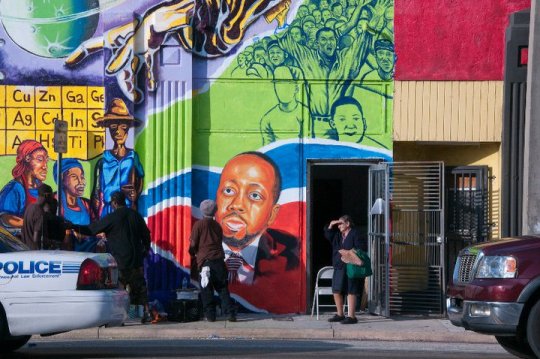
2. New York
Coming in second, but perhaps not as closely as you might think, is New York. With around half the number of Haitians as Florida, New York checks in at 131,000. The vast majority of these Haitians are living in (you guessed it) New York City. New York, which also has its own Little Haiti, even hosts a Haitian Day Parade in May (which, by the way, is Haitian Heritage month in the United States, celebrated primarily in the northeast, including – spoiler alert! – Boston, Massachusetts).
3. Massachusetts
Well, since we just gave it away…we’ll roll right into #3 on the list, Massachusetts! Massachusetts is home to approximately 46,000 Haitians, with most living in the Boston metropolitan area. Boston has even established a number of social service organizations to serve its Haitian population, including the Association of Haitian Women in Boston, the Haitian Multi-Service Center, the Haitian Health Outreach Project, and a Haitian Mental Health Unit at Cambridge Hospital.
4. New Jersey
Next on our list…New Jersey! New Jersey follows closely behind Massachusetts with a Haitian population of 39,000. This is the last state on our list to have a rather large Haitian community (the rest have 15,000 or less). New Jersey’s Haitian population is still large enough to have made its mark on the state. Particularly in Essex County, you can see the Haitian influence in music shops, grocery stores, restaurants, and even barbershops.
5. Georgia
Here’s where our numbers begin to drop significantly, so give yourself a pat on the back if you got the rest of these right! This state has less than half the Haitian population of New Jersey, and a tiny fraction compared to our big #1. Nevertheless, Florida’s northern neighbor comes in at #5 with 15,000 Haitians residing within its borders. As you might expect, our Haitian friends are concentrated in the Atlanta area. However, interestingly enough, Haitians have taken up residence not in Fulton County (home to Atlanta) itself, but have rather spread out fairly evenly to the east, west, and south of Atlanta.
6. Pennsylvania
The next three states on our list bring us back up to the northeast, starting with Pennsylvania at 13,000. Philadelphia lacks the concentration of Haitians that exists in New York, but its lower cost of living has begun to draw many of the Haitian immigrants who entered the U.S. through New York.
7. Connecticut
Connecticut follows closely behind at 12,000. Together with Haitians in nearby New Jersey and New York, Haitians in Connecticut have founded several Haitian Creole-speaking religious institutions, radio and television programs, and after-school programs.
8. Maryland
Maryland, just north of the D.C. area, follows Connecticut with a Haitian population of 8,000. Although there don’t seem to be as many Haitians in D.C. as you might think, the Washington-based organization Roots of Development did start a Taste of Haiti event, attended by ambassadors, business leaders, journalists, heads of NGO’s, embassy staff, and of course, Haitians themselves. Wouldn’t you have loved to have been at this Haitian food competition? Yum!
9. Illinois
Our only state in the midwest with a significant Haitian population lends all of its credit to Chicago, where the majority of Illinois’s 6,000 Haitian immigrants live. While most Haitians have settled north of the Chicago area, Chicago differs from our northeastern cities in that the Haitians in Chicago are widely dispersed. You won’t find a Little Haiti in Chicago. However, you will find two Haitian-American public officials from Chicago, State Senator Kwame Raoul and Illinois Supreme Court Judge Lionel Jean-Baptiste.
10. Texas
Last but not least, Texas bottoms out with a modest population of 4,000 Haitians. Despite the smaller number of Haitian immigrants, in October of 2011, Austin, Texas established a “Friendship City” relationship with Jacmel, Haiti, based on their shared creative culture.
There you have it, your top ten U.S. states where Haitian immigrants have made their homes. For those of you who had California on your list, give yourselves a bonus point! Although this highly populated, culturally diverse state didn’t make the top ten, it takes a close backseat to Texas with a Haitian population of 3,000.
So now you know…the next time you happen to be in one of these areas, make sure to add “check out Haitian restaurants” to your list, and get a taste for Haitian cuisine while getting to know a few of your Haitian neighbors!
Are you from one of these states? Not from one of these states, but have a heart for Haiti? Make sure to check out www.restavekfreedom.org and learn more about our work in Haiti and how you can get involved!
Resources:
https://www.gc.cuny.edu/CUNY_GC/media/CUNY-Graduate-Center/PDF/Certificate%20Programs/Africana%20Studies/03-07-14-JPlaisir-Haitian-Transnational-Communities-in-the-United-States.pdf
https://en.wikipedia.org/wiki/Haitian_Heritage_Month
http://www.migrationpolicy.org/programs/data-hub/charts/us-immigrant-population-state-and-county?width=1000&height=850&iframe=true
https://en.wikipedia.org/wiki/Haitian_Day_Parade
http://www.bmc.org/haitianhealth/communityresources.htm
http://ballotpedia.org/Lionel_Jean-Baptiste
https://en.wikipedia.org/wiki/Haitian_diaspora
http://www.haitilibre.com/en/news-3555-haiti-culture-jacmel-friendship-city-of-austin-texas.html
http://www.miamiandbeaches.com/places-to-see/little-haiti
http://amourcreole.com/enjoying-a-taste-of-haiti-haitian-cuisine-in-full-display-in-washington-d-c/
133 notes
·
View notes
Photo
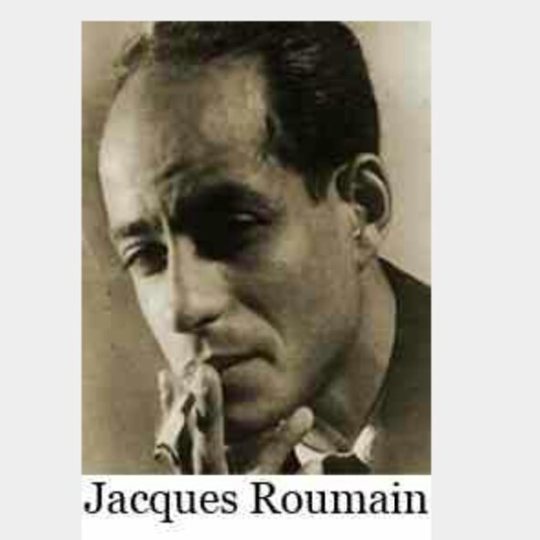
“Roumain was born on June 4, 1907, in Port-au-Prince to wealthy parents. His grandfather,Tancrède Auguste, served as the President of Haiti from 1912 to 1913. He was educated in Catholic schools in Port-au-Prince, and, later, in Belgium, Switzerland, France, Germany and Spain. At twenty years old, he returned to Haiti and formed La Revue Indigene: Les Arts et La Vie (The Indigenous Review: Arts and Life), along with Philippe Thoby-Marcelin, Carl Brouard, and Antonio Vieux.
He was active in the struggle against the United States’ occupation of Haiti. In 1934 he founded the Haitian Communist Party. Because of some of his political activities, his participation in the resistance movement against the United States’ occupation, and most notably, his creation of the Haitian Communist Party, he was often arrested and finally exiled by then President Sténio Vincent.
During his years in exile, Roumain worked with and befriended many prominent pan-African writers and poets of the time, including Langston Hughes. During this time he was also affiliated with Columbia University in New York City, where he conducted ethnographical research. With a change in government in Haiti, Roumain was allowed to return to his native country. Upon returning, he founded the Office of Ethnology. In 1943, President Élie Lescot appointed him chargé d'affaires in Mexico, where his newly found creative freedom permitted him to complete two of his most influential books, the poetry collection Bois D'ébène (Ebony Wood) and the novel, Gouverneurs de la Rosée (Masters of the Dew).
Much of Roumain’s work expresses the frustration and rage of people who have been downtrodden for centuries. He included the mass of the people in his writing and called on the poor union to move against privation.
On August 18, 1944, Jacques Roumain, one of Haiti’s most respected and complex writers, died of still unknown causes at age 37. Roumain created some of the most colorful, dynamic, and moving poetry of his generation. His writings continue to influence and shape Haitian culture and the pan-African world of today.”
#haiti #teamhaiti
#ayiti #ayibobo #teamayiti
24 notes
·
View notes
Link
Kat
August 28, 2015 at 08:00AM
Anedie Azael Doura Launches Miss World Haiti 2015 appeared first on Kreyolicious.com.
For a while there, it looked as if #TeamHaiti would be deprived of its usual stream of pageants this year. Well, former Miss Haiti Anedie Azael Doura won’t let this happen. The one-time beauty queen and owner of Scandal Beauty is taking the reigns of the Miss Haiti Universe pageant. Anedie held a call for contestants. Lots of ladies showed up. Here is the former Miss Haiti herself Anedie, flanked by the contestants of this year’s edition. The judges have all their criteria in front of them, and with it, they’ll begin the elimination process to dwindle the numbers to just a select few. Say cheese! Some of the preliminary finalists for Miss World Haiti pose for the camera. Here are a few more ladies showing off their best poses. So Miss World Haiti has officially launched! Let’s see which kreyolicious cherie will get the crown. CLICK HERE TO READ ABOUT HAITIAN BEAUTY QUEENS!
Anedie Azael Doura Launches Miss World Haiti 2015 appeared first on Kreyolicious.com.
http://twitter.com/kreyolicious
http://ift.tt/1z0Vsyi
http://ift.tt/1Gp6Xz8
7 notes
·
View notes
Photo

Port-au-Prince, Haiti
35 notes
·
View notes
Video
youtube
Kwame Ture (Stokely Carmichael) on Haiti. From an interview in the US in the mid-1990s.
29 notes
·
View notes
Photo

Stop by our workshop today 😁 We are open and waiting for you ! And if you cant … Stop by kay atizan in PV for a satuday local shopping ! by lokonationhaiti http://ift.tt/1BOzaRx curated by CURΛTEDMEDIΛ @hipartmedia
16 notes
·
View notes
Photo

I don’t think ill ever stop loving this one ! by lokonationhaiti http://ift.tt/1IDOMUX curated by CURΛTEDMEDIΛ @hipartmedia
10 notes
·
View notes
Photo

BECUZ we are HAITIAN QUEENS BY @amytheard 🇭🇹 TAG A HAITIAN QUEEN! #Lunionsuite #Haitian #artist #haitianwomen #queen #Haiti
40 notes
·
View notes
Link
Dominican-American author Junot Diaz and Haitian-American author Edwidge Danticat have joined forces to decry the crisis in the Dominican Republic.
“There is a state of terror in the Dominican Republic,” said Diaz, the Pulitzer Prize winning author of The Brief Wondrous Life Of Oscar Wao, at a gathering in Miami’s Little Haiti neighborhood.
23 notes
·
View notes
Quote
Through the body we build identity, we reason, communicate. For centuries, black people have used dance to tell our stories, wishes and desires; through dance we express the feelings that are beyond the Eurocentric reason trying to subdue the emotional displays of bodies.
In "Da pa lo' do" Rita Indiana brings us to dance and it challenges the recognition of a common history, a common past between the two peoples, it can be recreated and understood from other speech registers: through rhythm and the dance.
Dialogue from the pace offers the opportunity to converge at a common point beyond the insularity that alienates us to the point of distorting important part of our history. For us, Dominicans and Haitians, dance lends itself as a vehicle to sail the seas on a journey that leads to "the embrace of the same grandfather" and with it a ticket to a metaspace historically shared.
Through dance our bodies are able to communicate without ideological bonds that are rooted in the already instituted imaginary from verbal and written, then the dance conceived as a discursive space while performative action, keeps inside a power He insists and persists to the passage of time.
(Translated from Spanish)
5 notes
·
View notes
Photo
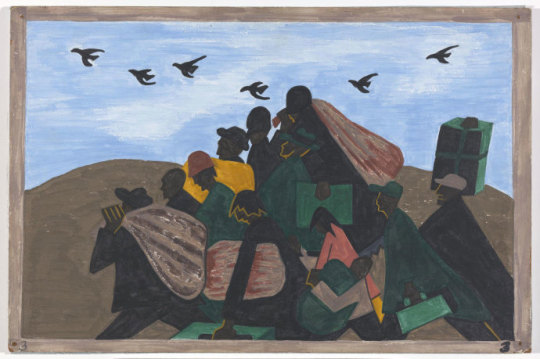
Black Bodies in Motion and in Pain By Edwidge Danticat
“This past weekend, between not sleeping and constantly checking the news, I walked the long rectangular room at New York’s Museum of Modern Art, where Jacob Lawrence’s “Migration Series” is currently on display. I had seen many of the paintings before, in books and magazines, but never “in person.” I’d somehow expected them to be as colossal as their subject, the fifty-five-year-plus mass migration of more than six million African-Americans from the rural south to urban centers in the northern United States. The sixty spare and, at times, appropriately stark tempera paintings in the series each measure twelve-by-eighteen inches and are underscored by descriptive captions written by the artist, whose parents moved from Virginia and South Carolina to New Jersey, where he was born. The size of the paintings quickly became inconsequential as I moved from panel to panel, the first one showing a crowd of people crammed into a train station and filing toward ticket windows marked Chicago, New York, Saint Louis, and the last panel returning us to yet another railroad station, showing that in spite of dangerous and unhealthy working conditions and race riots in the North, the migrants “kept coming.”
At the end of a week when nine men and women were brutally assassinated by a racist young man in Charleston, South Carolina, and the possibility of two hundred thousand Haitians and Dominicans of Haitian descent being expelled from the Dominican Republic suddenly became very real, I longed to be in the presence of Lawrence’s migrants and survivors. I was yearning for their witness and fellowship, to borrow language from some of the churches that ended up being lifelines for the Great Migration’s new arrivals. But what kept me glued to these dark silhouettes is how beautifully and heartbreakingly Lawrence captured black bodies in motion, in transit, in danger, and in pain. The bowed heads of the hungry and the curved backs of mourners helped the Great Migration to gain and keep its momentum, along with the promise of less abject poverty in the North, better educational opportunities, and the right to vote.
��
As many Haitian migrants and immigrants and Dominicans of Haitian descent now either go into hiding or leave the Dominican Republic out of fear, we are witnessing, once again, a sea of black bodies in motion, in transit, and in danger. And as Emanuel African Methodist Episcopal Church and the larger community of Charleston, South Carolina, prepare to bury their dead, we will once again be seeing black bodies in pain. And we will be expected to be exceptionally graceful mourners. We will be expected to stifle our rage. And we will keep asking ourselves, When will this end? When will it stop?“
25 notes
·
View notes






